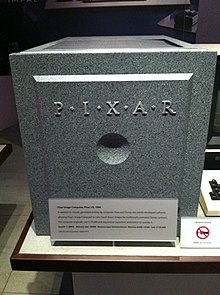User:Ehm2233/sandbox
Early history[edit]

Pixar got its start in 1974, when New York Institute of Technology's (NYIT) founder, Alexander Schure, who was also the owner of a traditional animation studio, established the Computer Graphics Lab (CGL) and recruited computer scientists who shared his ambitions about creating the world's first computer-animated film. Edwin Catmull and Malcolm Blanchard were the first to be hired and were soon joined by Alvy Ray Smith and David DiFrancesco some months later, which were the four original members of the Computer Graphics Lab, located in a converted two-story garage acquired from the former Vanderbilt-Whitney estate.[1][2]In the years prior to joining, Catmull had invented texture mapping and had produced the first computer animated film (of his hand). At NYIT, the researchers were given unprecedented technology of the day, and with that, pioneered many of the CG foundation techniques—in particular, the invention of the alpha channel by Catmull and Smith.[3] Schure kept pouring money into the lab, an estimated $15 million, giving the group everything they desired but driving NYIT into serious financial troubles.[4] Eventually, the group realized they needed to work in a real film studio in order to reach their goal.
By 1979, during pre-production for The Empire Strikes Back, George Lucas approached Catmull and offered him an opportunity to build a computer group at his studio to solve three specific problems he was having concerning editing, sound post production, and special effects. Catmull joined, and during the following months, his associates from CGL gradually resigned, found temporary jobs (to avoid making Schure suspicious), and eventually joined what became the "Graphics Group" at Lucasfilm.[5][6][7]
While Catmull ran the Lucasfilm Computer Division, Alvy Ray Smith was specifically in charge of the Graphics Group. The team, expanded importantly in 1980 to include Loren Carpenter (a pioneer of fractal graphics) and other key scientists, began developing the foundations for animation, a project they understood could take more than a decade. The team worked on creating the precursor to RenderMan, called REYES (for "renders everything you ever saw") and developed several critical technologies for CG—including particle effects and various animation tools.[8]
- ^ "Brief History of the New York Institute of Technology Computer Graphics Lab". Carnegie Mellon University. Archived from the original on March 3, 2016. Retrieved January 1, 2016.
- ^ "Loonshots: How to Nurture the Crazy Ideas That Win Wars, Cure Diseases, and Transform Industries". Archived from the original on October 31, 2020. Retrieved October 27, 2020.
- ^ Smith, Alvy Ray (August 15, 1995). "Alpha and the History of Digital Compositing" (PDF). Princeton University—Department of Computer Science. Archived (PDF) from the original on August 10, 2017. Retrieved December 22, 2013.
- ^ "The Story Behind Pixar – with Alvy Ray Smith". mixergy.com. Archived from the original on December 26, 2015. Retrieved December 25, 2015.
- ^ "CGI Story: The Development of Computer Generated Imaging". lowendmac.com. June 8, 2014. Archived from the original on November 25, 2015. Retrieved October 23, 2015.
- ^ "ID 797 – History of Computer Graphics and Animation". Ohio State University. Archived from the original on January 10, 2016. Retrieved October 23, 2015.
- ^ Rubin, Michael (2006). Droidmaker : George Lucas and the digital revolution. Gainesville, Fla.: Triad Pub. Co. ISBN 0-937404-67-5. OCLC 60856108.
- ^ "Everything You Ever Saw | Computer Graphics World". www.cgw.com. 32. February 2009. Retrieved 2022-02-13.

